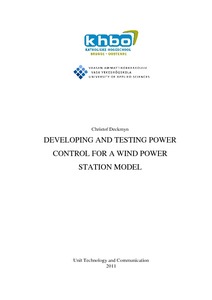Developing and testing power control for wind power model
Deckmyn, Christof; Deckmyn, Christof (2011)
Deckmyn, Christof
Deckmyn, Christof
Vaasan ammattikorkeakoulu
2011
All rights reserved
Julkaisun pysyvä osoite on
https://urn.fi/URN:NBN:fi:amk-201105259577
https://urn.fi/URN:NBN:fi:amk-201105259577
Tiivistelmä
This thesis investigates a power algorithm for small wind turbines without pitch control. This research suggests the possibility to produce the maximum power at every wind speed using an electrical braking torque.
The set up of the research took place in a laboratory without real wind. Therefore, a hardware model of wind turbine, instead of a real wind turbine was required. A motor, controlled by a frequency converter and mechanically coupled to the shaft of the generator simulated the wind. A second frequency converter connected to the generator generated a braking torque. A third frequency converter delivered power to the grid. Using a PLC we a wind pattern could be integrated in order to simulate a real wind model with the motor.
A power algorithm shows how we can respond to the tip speed of the blades with the braking torque in order to keep the maximum power coefficient.
The set up of the research took place in a laboratory without real wind. Therefore, a hardware model of wind turbine, instead of a real wind turbine was required. A motor, controlled by a frequency converter and mechanically coupled to the shaft of the generator simulated the wind. A second frequency converter connected to the generator generated a braking torque. A third frequency converter delivered power to the grid. Using a PLC we a wind pattern could be integrated in order to simulate a real wind model with the motor.
A power algorithm shows how we can respond to the tip speed of the blades with the braking torque in order to keep the maximum power coefficient.
